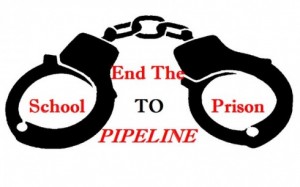Peer-reviewed articles, also referred to as scholarly articles, can be incredibly insightful when exploring a topic because they are written by professionals in the field and reviewed extensively by other professionals. For this site’s exploration about the school-to-prison pipeline, two peer-reviewed articles have been incorporated into the analysis of the issue. These include “Shifting from Zero Tolerance to Restorative Justice in Schools” by Martell Teasley 30 and “ Enhancing Educators’ Capacity to Stop the School-to-Prison Pipeline” by Jane Coggshall, David Osher, and Greta Colombi, 31 both of which explore the negative influences of zero tolerance policies and suggest alternatives to this disciplinary system as well as ways to combat the school-to-prison pipeline.

40
Both of the articles attribute the school-to-prison pipeline as, at least partially, a result of zero tolerance policies and outright reject the way in which so many schools rely on these policies to solve disciplinary issues. Teasley actually refers to zero tolerance policies as the “catalyst for the school-to-prison pipeline.” 30 He elaborates on how zero tolerance policies overemphasize severe punishments such as suspensions, expulsions, involvement of the criminal justice system, etc. and apply these disciplinary policies to such an extensive range of behaviors. 30 Coggshall, Osher, and Colombi also refer to the overemphasis of removal policies and claim that they are rarely successful in changing behavior and usually just contribute to additional negative impacts for the student. Additionally, they are ultimately implying that teachers lack empathy for their students and do not care to take into account different personal circumstances, such as cultural variations or the impact of poverty, which may have contributed to the students misbehavior in the first place. 31 Teasley agrees with the belief that zero tolerance policies only create additional problems and reduce the success of the individual; he discusses how they contribute to student withdrawal and noncompliance in general, absence which often leads to drop-out, and resentment as well as lack of trust toward school authority. 30

41
Furthermore, both of the articles address the growing diversity of the student body and discuss how this impacts the school system. Coggshall, Osher, and Colombi particularly focus on the significance of teachers recognizing the diversity of their students’ needs and accounting for personal influences that contribute to the range of behavior and learning styles that exist within a single classroom. 31 Teasley instead examines the racial inequality that is emphasized through the implementation of these policies and addresses how they particularly target students with disabilities as well as minority students, especially blacks and Hispanics. 30
Finally, a dominant aspect of both of the articles is their focus on how the school-to-prison pipeline can be diminished. Both articles appear hopeful about how the system can be changed and provide suggestions about how to accomplish this. Coggshall, Osher, and Colmobi focus on how the teacher is the key influencer and changes in his or her behavior can alter the effects of the school-to-prison pipeline 31 while Teasley emphasizes the implementation of a new form of disciplinary action which requires the cooperation of the whole community. 30 Coggshall, Osher, and Colombi introduce four core ways in which teachers can address the school-to-prison pipeline to improve learning conditions for all, rather than encouraging certain students to leave the education system. First, they discuss the importance of enhancing teacher-student relationships in order to build a sense of trust and develop a support network. Secondly, they address the importance of teachers exhibiting an optimistic attitude and challenging their students by establishing high expectations. By doing this, each student will feel as if their teacher has confidence in their abilities, will be encouraged to work hard, and will also be ensured that their teacher believes in their ability to succeed. Thirdly, the authors believe that the teachers must create a safe environment in the classroom – both physically and emotionally – at all times, challenge the students in a reasonable manner, and provide them with the support that is necessary to help them achieve. Lastly, and the most important requirement according to the authors, when disciplinary action is necessary, teachers should carefully evaluate each situation individually before deciding how to respond. 31

42
Teasley’s idea for reforming the school disciplinary system is the implementation of restorative justice policies, a system that some schools have already adopted. Restorative justice requires commitment from teachers but also the whole community and focuses on keeping students in the community but changing their actions through a process of mutual respect. According to Sumner, “‘A major appeal for using a restorative approach to discipline as an alternative to zero-tolerance policies is the emphasis on respect, accountability, repair of harm, and restoration of community rather than on punishment and exclusion.’” 30 It is a system that addresses the issues and holds students accountable for their actions but works with them to change their behavior rather than ejecting them from the system entirely. 30 Both articles emphasize the importance of eradicating the zero tolerance policies, and although they introduce different techniques to accomplish this, both seem to offer reasonable solutions that could reduce the existence of the school-to-prison pipeline in the future.
